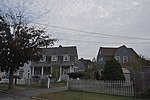Rural Cemetery and Friends Cemetery

The Rural Cemetery and Friends Cemetery are a pair of connected cemeteries at 149 Dartmouth Street in New Bedford, Massachusetts United States. They occupy an irregular parcel of land more than 90 acres (36 ha) in size on the west side of the city. Established in 1837, the Rural Cemetery was the fifth rural cemetery in the nation, after Mount Auburn Cemetery (Cambridge, Massachusetts), Mount Hope Cemetery (Bangor, Maine), Mount Pleasant Cemetery (Taunton, Massachusetts), and Laurel Hill Cemetery (Philadelphia, Pennsylvania). In its early days it was criticized as lacking some of the natural beauty afforded by rolling terrain; the early sections were laid out in rectilinear manner on relatively flat terrain. The cemetery was a popular burial site, including notably the landscape artist Albert Bierstadt and Governor of Massachusetts John H. Clifford.In contrast to the more decorative nature of the Rural Cemetery, the Friends Cemetery is much plainer. It consists of a roughly 2-acre (0.81 ha) parcel on one side of the Rural Cemetery, which was sold to the Dartmouth Friends in 1849, but is administered by the city. This section has less ornate markers, generally laid out in rectilinear fashion. It includes burials that were relocated from a Friends cemetery (dating to 1793) that had been located on the New Bedford waterfront.The cemeteries were listed on the National Register of Historic Places in 2014.
Excerpt from the Wikipedia article Rural Cemetery and Friends Cemetery (License: CC BY-SA 3.0, Authors, Images).Rural Cemetery and Friends Cemetery
Oak Street, New Bedford
Geographical coordinates (GPS) Address Nearby Places Show on map
Geographical coordinates (GPS)
| Latitude | Longitude |
|---|---|
| N 41.6229 ° | E -70.9354 ° |
Address
Oak Street 48R
02740 New Bedford
Massachusetts, United States
Open on Google Maps









